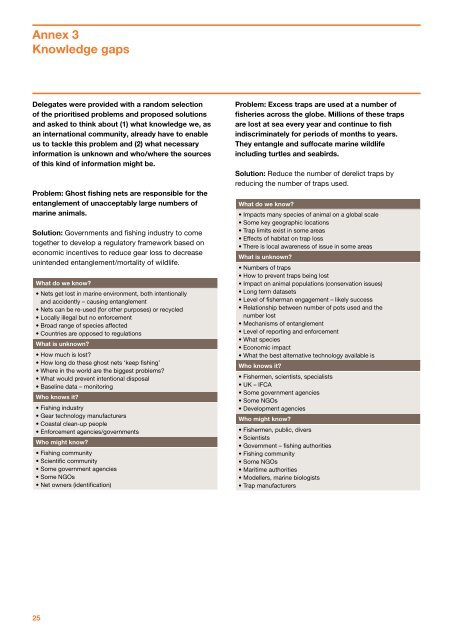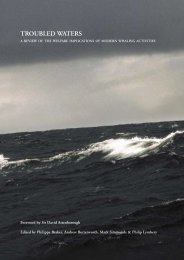Proceedings of the Untangled symposium: - WSPA
Proceedings of the Untangled symposium: - WSPA
Proceedings of the Untangled symposium: - WSPA
You also want an ePaper? Increase the reach of your titles
YUMPU automatically turns print PDFs into web optimized ePapers that Google loves.
Annex 3Knowledge gapsDelegates were provided with a random selection<strong>of</strong> <strong>the</strong> prioritised problems and proposed solutionsand asked to think about (1) what knowledge we, asan international community, already have to enableus to tackle this problem and (2) what necessaryinformation is unknown and who/where <strong>the</strong> sources<strong>of</strong> this kind <strong>of</strong> information might be.Problem: Ghost fishing nets are responsible for <strong>the</strong>entanglement <strong>of</strong> unacceptably large numbers <strong>of</strong>marine animals.Solution: Governments and fishing industry to cometoge<strong>the</strong>r to develop a regulatory framework based oneconomic incentives to reduce gear loss to decreaseunintended entanglement/mortality <strong>of</strong> wildlife.What do we know?• Nets get lost in marine environment, both intentionallyand accidently – causing entanglement• Nets can be re-used (for o<strong>the</strong>r purposes) or recycled• Locally illegal but no enforcement• Broad range <strong>of</strong> species affected• Countries are opposed to regulationsWhat is unknown?• How much is lost?• How long do <strong>the</strong>se ghost nets ‘keep fishing’• Where in <strong>the</strong> world are <strong>the</strong> biggest problems?• What would prevent intentional disposal• Baseline data – monitoringWho knows it?• Fishing industry• Gear technology manufacturers• Coastal clean-up people• Enforcement agencies/governmentsWho might know?• Fishing community• Scientific community• Some government agencies• Some NGOs• Net owners (identification)Problem: Excess traps are used at a number <strong>of</strong>fisheries across <strong>the</strong> globe. Millions <strong>of</strong> <strong>the</strong>se trapsare lost at sea every year and continue to fishindiscriminately for periods <strong>of</strong> months to years.They entangle and suffocate marine wildlifeincluding turtles and seabirds.Solution: Reduce <strong>the</strong> number <strong>of</strong> derelict traps byreducing <strong>the</strong> number <strong>of</strong> traps used.What do we know?• Impacts many species <strong>of</strong> animal on a global scale• Some key geographic locations• Trap limits exist in some areas• Effects <strong>of</strong> habitat on trap loss• There is local awareness <strong>of</strong> issue in some areasWhat is unknown?• Numbers <strong>of</strong> traps• How to prevent traps being lost• Impact on animal populations (conservation issues)• Long term datasets• Level <strong>of</strong> fisherman engagement – likely success• Relationship between number <strong>of</strong> pots used and <strong>the</strong>number lost• Mechanisms <strong>of</strong> entanglement• Level <strong>of</strong> reporting and enforcement• What species• Economic impact• What <strong>the</strong> best alternative technology available isWho knows it?• Fishermen, scientists, specialists• UK – IFCA• Some government agencies• Some NGOs• Development agenciesWho might know?• Fishermen, public, divers• Scientists• Government – fishing authorities• Fishing community• Some NGOs• Maritime authorities• Modellers, marine biologists• Trap manufacturers25
















